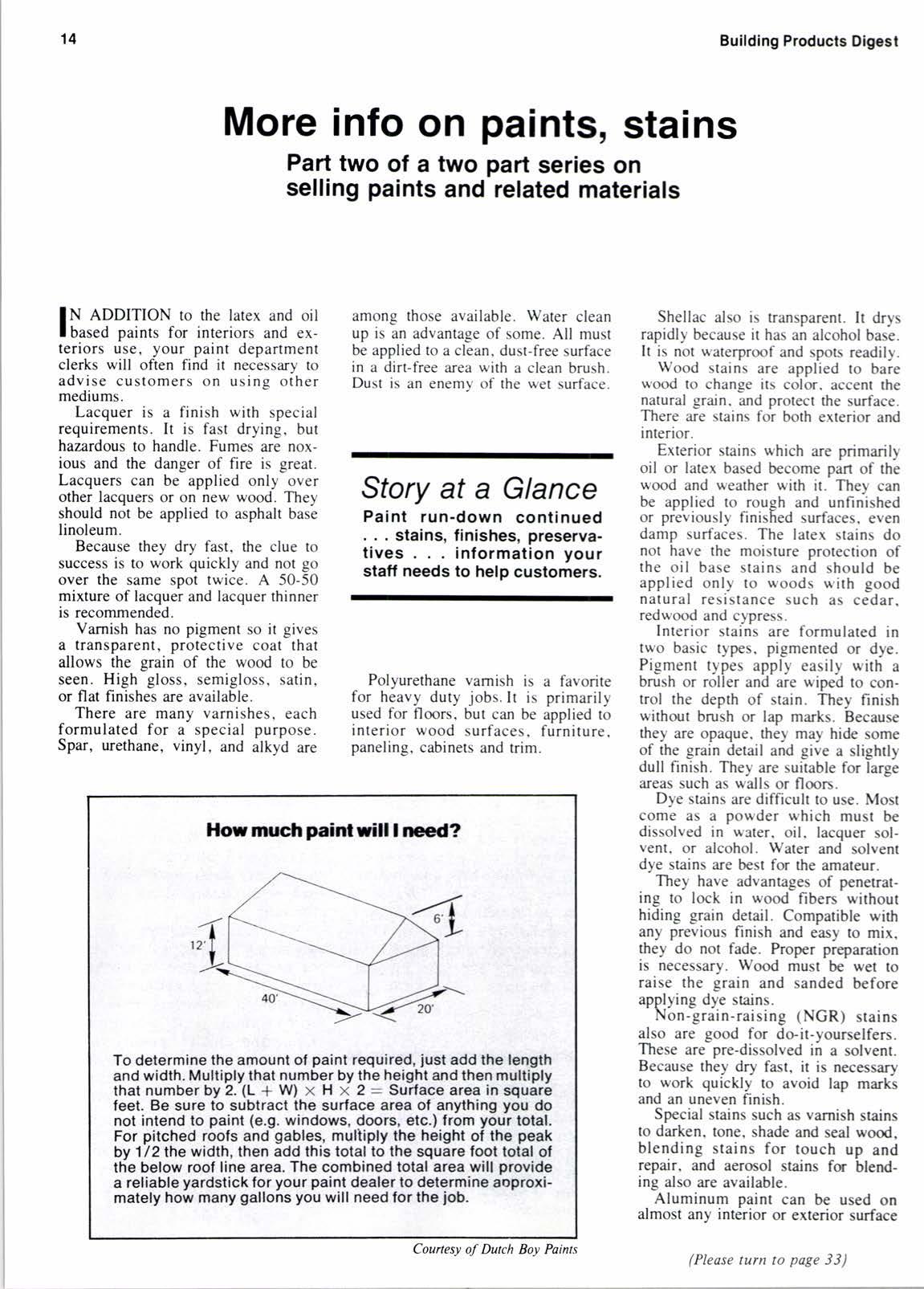
2 minute read
More info on paints, stains
Part two of a two part series on selling paints and related materials
lN ADDITION to rhe latex and oil I based paints for interiors and exteriors use, your paint department clerks will often find it necessary to advise customers on usins other mediums.
Lacquer is a finish with special requirements. It is fast drying, but hazardous to handle. Fumes are noxious and the danger of fire is great. Lacquers can be applied only over other lacquers or on new wood. They should not be applied to asphalt base linoleum.
Because they dry fast, the clue to success is to work quickly and not go over the same spot twice. A 50-50 mixture of lacquer and lacquer thinner is recommended.
Varnish has no pigment so it gives a transparent, protective coat that allows the grain of the wood to be seen. High gloss, semigloss, satin, or flat finishes are available.
There are manv varnishes. each formulated for a'special purpose. Spar, urethane, vinyl, and alkyd are among those available. Water clean up is an advantage of some. All must be applied to a clean, dust-free surface in a dirtfree area with a clean brush. Dust is an enemy of the wet surface.
Story at a Glance
Paint run-down continued stains, finishes, preserva- tives inlormation your staff needs to help customers.
Polyurethane varnish is a favorite for heavy duty jobs.lt is primarily used for floors, but can be applied to interior wood surfaces. furniture. paneling, cabinets and trim.
]lou rrucfi paint rill I necd?
To determine the amount of paint required, iust add the length and width. Multiply that number by the height and then multiply that number by 2. (L * W) x H x 2 = Surface area in square feet. Be sure to subtract the surface area of anything you do not intend to paint (e.9. windows, doors, etc.) lrom your total. For pitched rools and gables, mulliply the height of the peak by 1/2 the width, then add this total to the sguare foot total of the below roof line area. The combined total area will provide a reliable yardstick for your paint dealer to determine aoproximately how many gallons you will need for the job.
Shellac also is transparent. It drys rapidly because it has an alcohol base. It is not waterproof and spots readily. Wood stains are applied to bare wood to change its color. accent the natural grain. and protect the surface. There are stains for both exterior and interior.
Exterior stains which are primarily oil or latex based become part of the wood and weather with it. They can be applied to rough and unfinished or previously finished surfaces. even damp surfaces. The latex stains do not have the moisture protection of the oil base stains and should be applied only to woods u,ith good natural resistance such as cedar. redwood and cypress.
Interior stains are formulated in two basic types. pigmented or dye. Pigment types apply easily with a brush or roller and are wiped to control the depth of stain. They finish without brush or lap marks. Because they are opaque. they may hide some of the grain detail and give a slightly dull finish. They are suitable for large areas such as walls or floon.
Dye stains are difficult to use. Most come as a powder which must be dissolved in wster, oil. lacquer solvent, or alcohol. Water and solvent dye stains are best for the amateur.
They have advantages of penetrating to lock in wood fibers without hiding grain detail. Compatible wirh any previous finish and easy to mix. they do not fade. Proper preparation is necessary. Wood must be wet to raise the grain and sanded before applying dye stains.
Non-grain-raising (NGR) stains also are good for do-it-yourselfers. These are-pre-dissolved in a solvent. Because they dry fast, it is necessary to work quickly to avoid lap marks and an uneven finish.
Special stains such as varnish stains to darken, tone, shade and seal wood, blending stains for touch up and repair, and aerosol stains fc blending also are available.
Aluminum paint can be used on almost any intdrior or exterior surface










